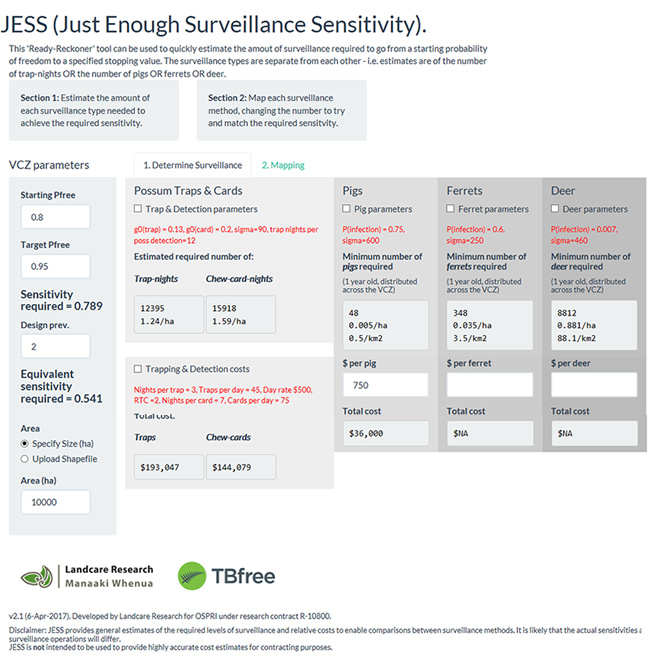JESS (Just Enough Surveillance Sensitivity): a flexible decision support tool for TB surveillance

TB lesion in the armpit of a brushtail possum.
Bovine tuberculosis (TB) is a livestock disease that also infects humans. It is caused by a bacterium (Mycobacterium bovis) that evolved from the strain that causes human TB. Globally TB is still a major threat to human and animal health, with longstanding efforts to reduce or eradicate the disease ongoing in many countries.
In New Zealand eradication of TB is difficult because it became established in brushtail possum populations over about 40% of the country (10.4 million ha). Possums are the main wildlife host: they act as independent reservoirs of infection and readily transmit TB to farmed cattle and deer. To reduce the threat to human and animal health, OSPRI (formerly the Animal Health Board), operating under a National Pest Management Plan (NPMP), has made concerted efforts since 1994 to reduce and eliminate TB from wildlife. In July 2016 the NPMP goals were extended to include, for the first time, biological eradication of the disease from the whole country by 2055, and, as an intermediate milestone, to achieve TB freedom in possums by 2040.
OSPRI declares local management areas (called Vector Control Zones, or VCZs) free of TB when it is about 95% confident that the disease has been eradicated from possums. To achieve freedom from all wildlife, OSPRI first carry out possum control to reduce and maintain the population at levels too low for TB to persist. Surveillance is then carried out to confirm freedom of wildlife from TB. Surveillance can involve a range of activities, including capturing and testing possums and sentinel species (i.e. spillover hosts that do not maintain the disease) such as ferrets, pigs and deer. The more cumulative surveillance carried out that does not detect the disease, the more confident managers are that the disease has indeed been locally eradicated from a given VCZ.
Given that surveillance can be extremely costly and that there are vast areas to be surveyed, it is desirable to carry out just enough surveillance to meet the desired level of confidence about TB freedom in a VCZ so that resources can then be directed to other areas. However, the amount of surveillance required varies widely between VCZs, depending on how confident managers are that TB has been eradicated, the size of the area, what TB hosts are present that can be used for surveillance, and what they might cost to survey. Until now there has been no easy way to assess the lowest-cost approach to surveillance.
Andrew Gormley and Graham Nugent of Landcare Research have developed an online decision support tool to predict the best mix of possum and/or sentinel surveillance for any given VCZ. This tool, JESS (Just Enough Surveillance Sensitivity), takes into account a range of factors, including the current probability of freedom from TB, the area of the VCZ, the home range and trappability of possums and sentinels, and the relative costs of surveying them.
JESS is designed to be easy to use and flexible: the user can enter VCZ-specific unit costs associated with possum and sentinel surveillance, as well as VCZ-specific estimates of their home range and trappability. The tool uses a simplified version of the sophisticated computer software package (called Proof of Freedom, PoF) that OSPRI uses to calculate probabilities of TB freedom after all of the surveillance data have been gathered. In contrast, JESS predicts in advance the area-wide surveillance sensitivities that would result from various mixtures of wildlife and an estimate of total surveillance costs. By using the same methodology as the PoF utility, the estimates of survey sensitivity are entirely consistent with those obtained by entering actual survey information.
The first stage of JESS has been developed in close collaboration with key OSPRI staff (such as area disease managers). This close working relationship has ensured that JESS was adopted by managers as soon as it became available in late 2016, and by early 2017 its predictions were being routinely incorporated into the operational planning of surveillance programmes.
By allowing managers to easily and quickly determine the minimum amount and type of surveillance required to achieve TB freedom in VCZs, the app is expected to result in significant savings of both cost and time. This will result in faster progress toward TB freedom, and ultimately the eradication of TB from possums nationally.

This work was funded by OSPRI.
Andrew Gormley (Landcare Research) gormleya@landcaareresearch.co.nz
